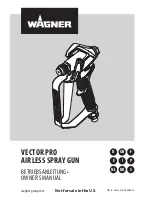
5
–
Fill the fuel tank outdoors, and fill it to about 1 inch
(25 mm) below the top of the tank (the bottom of
the filler neck). Do not overfill it.
–
Wipe up any spilled gasoline.
While Operating
Engine exhaust contains carbon monoxide, which
is an odorless, deadly poison that can kill you.
Do not run engine indoors or in an enclosed area.
Warning
•
The operator should remain seated whenever the
sprayer is in motion. The operator should keep both
hands on the steering wheel whenever possible. Keep
your arms and legs within the sprayer body at all times.
•
Always watch out for and avoid low overhangs such as
tree limbs, door jambs, and over-head walkways. Make
sure there is enough room over head to easily clear the
sprayer and your head.
•
Failure to operate the sprayer safely may result in an
accident, tip over of the sprayer, and serious injury or
death. Drive carefully. To prevent tipping or loss of
control:
–
Use extreme caution, reduce speed, and maintain a
safe distance around sand traps, ditches, creeks,
ramps, unfamiliar areas, or any areas that have
abrupt changes in ground conditions or elevation.
–
Watch for holes or other hidden hazards.
–
Use extra caution when operating the sprayer on wet
surfaces, in adverse weather conditions, at higher
speeds, or with a full load. Stopping time and
distance will increase with a full load.
–
Avoid sudden stops and starts. Do not go from
reverse to forward or forward to reverse without
first coming to a complete stop.
–
Slow down before turning. Do not attempt sharp
turns or abrupt maneuvers or other unsafe driving
actions that may cause a loss of sprayer control.
–
Before backing up, look to the rear and ensure that
no one is behind you. Back up slowly.
–
Watch out for traffic when you are near or crossing
roads. Always yield the right of way to pedestrians
and other vehicles. This sprayer is not designed for
use on streets or highways. Always signal your turns
or stop early enough so that other people know what
you plan to do. Obey all traffic rules and
regulations.
–
The electrical and exhaust systems of the sprayer
can produce sparks capable of igniting explosive
materials. Never operate the sprayer in or near an
area where there is dust or fumes in the air which
are explosive.
–
If you are ever unsure about safe operation, stop
work and ask your supervisor.
•
Do not touch the engine or muffler while the engine is
running or soon after it has stopped. These areas may be
hot enough to cause burns.
•
If the machine ever vibrates abnormally, stop
immediately, wait for all motion to stop, and inspect the
sprayer for damage. Repair all damage before resuming
operation.
•
Before getting off of the seat:
A. Stop the movement of the machine.
B. Place the range selector in Neutral and set the
parking brake.
C. Turn the ignition key to Off.
D. Remove the ignition key.
Note: If the sprayer is stopped on an incline, block the
wheels after getting off the sprayer.
Braking
•
Slow down before you approach an obstacle. This gives
you extra time to stop or turn away. Hitting an obstacle
can damage the sprayer and its contents. More
important, it can injure you and your passenger.
•
Gross Vehicle Weight (GVW) has a major impact on
your ability to stop and/or turn. Heavy loads and
attachments make a sprayer harder to stop or turn. The
heavier the load, the longer it takes to stop.
•
Turf and pavement are much slipperier when they are
wet. It can take 2 to 4 times as long to stop on wet
surfaces as on dry surfaces. If you drive through
standing water deep enough to get the brakes wet, they
will not work well until they are dry. After driving
through water, you should test the brakes to make sure
they work properly. If they do not, drive slowly while
putting light pressure on the brake pedal. This will dry
the brakes out.
Operating on Hills and Rough Terrain
Operating the sprayer on a hill may cause tipping or rolling
of the sprayer, or the engine may stall and you could lose
headway on the hill. This could result in personal injury.
•
Do not accelerate quickly or slam on the brakes when
backing down a hill, especially with a load.






































